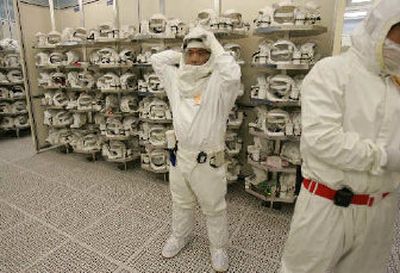Intel sees stronger revenue for second quarter

SAN JOSE, Calif. – In another sign the semiconductor industry is gaining strength, Intel Corp. boosted its second-quarter revenue forecast Thursday on better-than-expected demand for the chips that power notebook computers.
The Santa Clara, Calif.-based company said it now expects sales to be between $9.1 billion and $9.3 billion for the period ending July 2. In April, it predicted sales of between $8.6 billion and $9.2 billion.
“Demand feels pretty good right now,” said Andy Bryant, Intel’s chief financial officer. “It’s pretty simple.”
Analysts, on average, were expecting sales of about $8.99 billion, according to a survey by Thomson Financial. Though Intel does not provide earnings guidance, Wall Street is expecting a profit of 28 cents per share for the second quarter.
Intel reported earnings of 27 cents a share in the same period last year.
The strength in notebook chip sales isn’t a surprise. Earlier this month, the research firm Current Analysis said notebook sales outpaced desktop computer sales in May for the first time in the United States.
Intel has been focusing on improving the performance and battery life of notebook PCs since 2003, when it launched its Centrino brand that features a processor, chipset and wireless capability all tuned for mobile use.
Before the midquarter update was released, Intel shares closed at $27.70, up 60 cents, on the Nasdaq Stock Market. Afterward, they lost 41 cents in extended-session trading. They have traded between $19.64 and $28.85 over the past year.
Analysts said the positive update was expected, and the stock already reflected it.
“The midquarter update is largely, in my opinion, irrelevant for the stock,” said Apjit Walia, an analyst at RBC Capital Markets. “What really matters is what it does next (in the third quarter). That trend is what will dictate the stock’s fortunes.”
Intel isn’t the only chip maker to boost its guidance.
On Tuesday, Texas Instruments Inc. raised its second-quarter earnings guidance and narrowed its revenue outlook, citing higher demand for semiconductors and educational calculators.
A day later, the Semiconductor Industry Association boosted its forecast from flat to 6 percent growth in 2005, pointing to stronger demand for personal computers, cellular phones, digital televisions and digital cameras.
“Our cautious forecast issued in November of 2004 was based on concerns that high energy prices and lingering excess inventories in a few segments of the industry would dampen sales in 2005,” said SIA President George Scalise. “Those fears have not materialized.”
Chip makers, including Intel, did briefly suffer from excess inventory in 2004, but the industry quickly recovered. The amount never exceeded $1.5 billion, Scalise said.
That compares with 2000, when semiconductor companies reported $15 billion in excess inventory that took until 2003 to work down, he added.
“Everyone has talked about the industry making a comeback, but I never really thought it was down to begin with,” said Stephen Leeb of Leeb Capital Management. “There were certainly inventory issues. But, you had an absolutely blockbuster 2003 and in 2004 you saw reasonable growth – if that’s bad, then we’ll take it.”
In recent weeks, Intel has launched a number of new chips that it hopes will further drive growth and announced that it would supply microprocessors for Apple Computer Inc.’s Macintosh computers starting in the middle of next year.